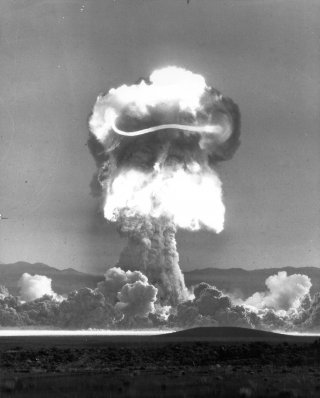Operation Plumbbob: How the U.S. Military Tested Nuclear Weapons Directly over Human Beings
Operation Plumbbob tested nuclear explosion safety—and their effect on live test subjects.
In the mid-1950s, the public was beginning to worry about the health consequences of nuclear fallout. In an effort to assuage the public, the U.S. Air Force thought it would be a good idea to conduct an aerial nuclear test—above a group of volunteers.
Welcome to Operation Plumbbob.
The nuclear weapon in question was the AIR-2 Genie air-to-air missile. Carried by an Air Force F-89 Scorpion jet, the nuclear-tipped missile was fired at an altitude of 18,500 feet. At two kilotons, the warhead was comparatively small by nuclear weapon standards. The Air Force hoped that the test, code-named John, would prove to the public that nuclear dogfights over urban areas posed no greater risk than conventional explosives.
Below ground zero, one photographer and five U.S. Air Force officers stood casually together on the ground, in uniform. None of them were wearing any protective gear—not even hats or long sleeves, although one officer wore a pair of dark-tinted sunglasses. The photographer fared a bit better in his getup—he wore a baseball cap.
Next to the group of men was an almost comically written hand-painted sign pinned to a wooden post and driven into the ground. On it was written “Ground Zero, population: 5.” The men looked skywards towards the two F-86 jets en route to the drop site. An extremely bright flash of white light saturated the scene and caused several men to shield their eyes and look away. Some seconds later, a shock wave hits, causing them to flinch and stagger slightly.
But, the men were not hurt. After the explosion, they laugh and shake hands. Slaps on the back make their way around, and a cigar is lit in celebration. No, this isn’t the stuff of bizarre science fiction—there is even a video of the event that captured the explosion and the five men’s reaction.
Desert Rocks
In addition to concerns about health risks to the public, the U.S. military also wanted to accurately gauge how a nuclear battlefield would alter military equipment and military maneuvers. What better way to test troop movements than by marching troops across a nuclear ground zero?
The tests were codenamed Desert Rock VII and VIII. During shot Hood, a Marine Corps helicopter airlift and tactical air support exercise was carried out. During shot Smoky, the Army conducted an airlift assault, and as a part of shot Galileo, Army troops were evaluated to test their psychological reactions to observing a nuclear explosion.
Guinea Pig Pigs
Another important piece of information that the military hoped to glean from the tests was more detailed information about how a person’s biology reacted to burns caused by nuclear explosions, and what kind of protective equipment could provide the best protection. The test subject: live pigs.
Hundreds of live pigs were exposed to nuclear fallout, often unshielded from the blast and subsequent thermal radiation. The amount of radioactive contamination they were exposed to was then measured. Many pigs suffered horrific burns to most of their bodies.
Postscript
The fate of most of the five Air Force officers seems to have been quite normal. As far as can be deduced, they seemed to have lived long lives, uncomplicated by the effects of nuclear exposure. The pigs—probably not so much.
Millions of dollars have been awarded to victims of nuclear testing under the framework of the Radiation Exposure Compensation Act. So-called “participants” of nuclear testing are entitled to one-time lump sum payments from the government, leading to the conclusion that the nuclear safety tests conducted as a part of Operation Plumbbob were not so safe after all.
Caleb Larson is a defense writer for the National Interest. He holds a Master of Public Policy and covers U.S. and Russian security, European defense issues, and German politics and culture.
Image: Wikimedia

